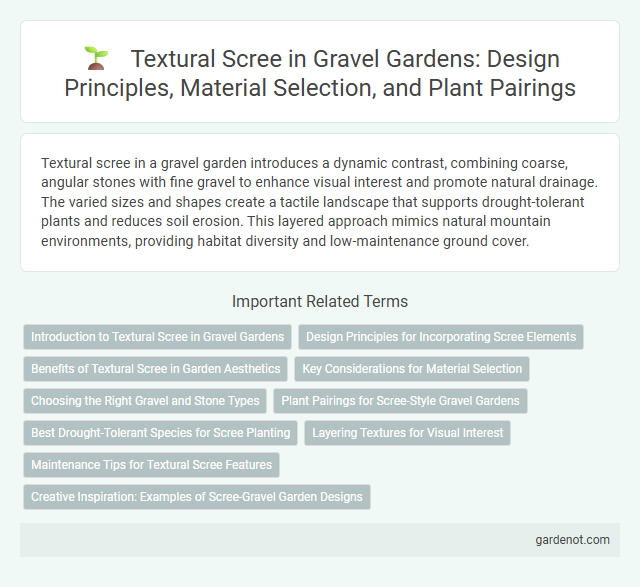Textural scree in a gravel garden introduces a dynamic contrast, combining coarse, angular stones with fine gravel to enhance visual interest and promote natural drainage. The varied sizes and shapes create a tactile landscape that supports drought-tolerant plants and reduces soil erosion. This layered approach mimics natural mountain environments, providing habitat diversity and low-maintenance ground cover.
Introduction to Textural Scree in Gravel Gardens
Textural scree in gravel gardens creates a dynamic landscape by combining various stone sizes and shapes to mimic natural mountain debris. This technique enhances visual interest through contrasting textures and promotes effective drainage, supporting drought-tolerant plantings. Gravel selections typically range from fine pebbles to larger angular rocks, emphasizing a layered and organic aesthetic.
Design Principles for Incorporating Scree Elements
In gravel garden design, integrating textural scree requires careful attention to scale, contrast, and layering to mimic natural rocky slopes effectively. Selecting a variety of stone sizes and textures enhances visual interest while promoting drainage and plant health. Emphasizing irregular placement and organic forms reinforces the authentic scree aesthetic and supports biodiversity within the garden ecosystem.
Benefits of Textural Scree in Garden Aesthetics
Textural scree enhances garden aesthetics by introducing diverse surface textures that create visual interest and depth in gravel gardens. Its varied stone sizes and irregular shapes mimic natural landscapes, providing a dynamic and organic appeal while improving drainage and reducing soil erosion. The contrasting textures also complement surrounding plants, highlighting foliage and blooms for a striking outdoor design.
Key Considerations for Material Selection
Textural scree in gravel gardens requires careful material selection to balance drainage, aesthetics, and plant health. Choosing angular, well-draining stones such as crushed granite or lava rock prevents compaction and supports drought-tolerant species. Material color and size impact soil temperature and visual contrast, influencing the garden's overall microenvironment and appeal.
Choosing the Right Gravel and Stone Types
Selecting the right gravel and stone types for a textural scree involves prioritizing durability, size variation, and natural color palettes to enhance aesthetic appeal and functionality. Opt for angular stones like granite or basalt for better interlocking and stability, combined with finer gravel to support drainage and prevent weed growth. Incorporating a mix of coarse and fine materials creates a balanced surface that both visually contrasts and complements the surrounding garden elements.
Plant Pairings for Scree-Style Gravel Gardens
Ideal plant pairings for textural scree-style gravel gardens include drought-tolerant succulents like Sedum and Sempervivum, which thrive in well-drained, rocky soil. Low-growing alpine plants such as Saxifraga and Thymus add contrasting textures and vibrant colors, enhancing the gravel's natural roughness. Incorporating ornamental grasses like Festuca and Carex introduces movement and softness, balancing the coarse gravel textures while supporting biodiversity.
Best Drought-Tolerant Species for Scree Planting
Best drought-tolerant species for textural scree planting include Sedum, Sempervivum, and Delosperma, known for their succulent leaves and low water requirements. These hardy plants thrive in well-draining, rocky substrates, providing a mix of textures and vibrant blooms that enhance gravel garden aesthetics. Incorporating drought-resistant grasses like Festuca and ornamental stonecrop varieties further optimizes scree planting for arid conditions.
Layering Textures for Visual Interest
Layering textures in a gravel garden enhances visual interest by combining varied scree sizes, from coarse stones to fine gravel, creating dynamic patterns and depth. Incorporating contrasting elements such as smooth pebbles alongside rough, angular rocks adds tactile diversity and natural appeal. This textural interplay mimics natural scree slopes, promoting a harmonious and engaging landscape design.
Maintenance Tips for Textural Scree Features
Textural scree in gravel gardens requires regular maintenance such as removing debris and controlling weed growth to preserve its distinct layered appearance and prevent plant competition. Raking the scree lightly helps maintain texture while promoting soil aeration without disturbing plant roots. Monitoring moisture levels ensures optimal drainage and supports the health of drought-tolerant species commonly used in scree landscaping.
Creative Inspiration: Examples of Scree-Gravel Garden Designs
Textural scree in gravel garden designs creates a dynamic landscape by combining coarse gravel with diverse stone sizes and shapes, fostering visual interest and natural aesthetics. Creative inspiration often draws from alpine scree slopes, using angular rocks, boulders, and fine pebbles to mimic rugged terrain and enhance drainage. Notable examples include layered gravel beds interspersed with native drought-tolerant plants, replicating mountainous environments while promoting biodiversity and low maintenance.
Textural scree Infographic

 gardenot.com
gardenot.com